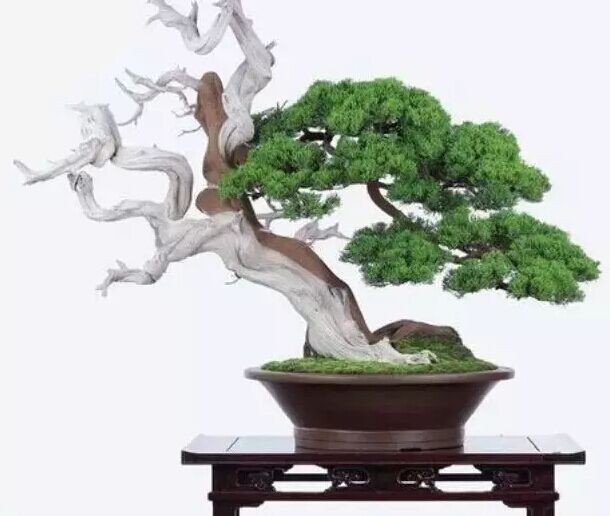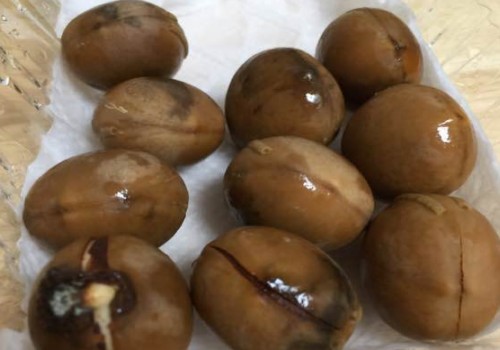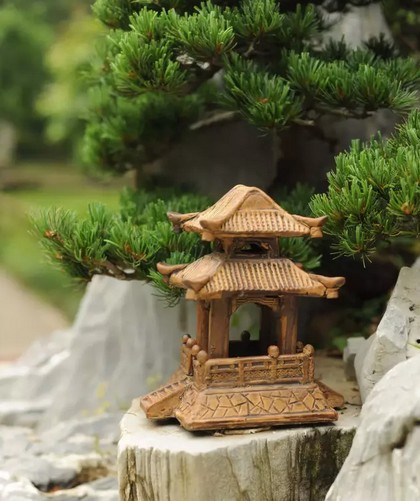Suzhou bonsai and its style characteristics
Suzhou bonsai, commonly known as Suzhou School, is a type of bonsai art style named after Suzhou. It centers on Suzhou and extends to many areas south of the Yangtze River, such as Changshu, Wuxi, Changzhou and so on. The representative figures are Zhou Lianjuan, Zhu Zian and so on.
Su-style bonsai is mainly based on tree bonsai, pay attention to nature, the shape changes with the pile, forming speed, getting rid of the traditional modeling shackles of long forming period, cumbersome formalities and rigid form in the past. Its artistic features are elegant and elegant, true and simple, vivid charm, scene blend, intriguing.

Most of the traditional Suzhou bonsai are in regular shape, and the most common one is "six sets, three supports and one roof". Nowadays, it is mainly "semi-regular", that is, the number of branches of trees is unlimited, shaped into a round shape, similar to the shape of "steamed bread". The overall shape is the common old tree shape in the south of the Yangtze River. The traditional forms of Suzhou bonsai are screen type, downwind type, hanging branch type, split type and so on. Su style landscape bonsai mainly shows the beautiful mountains and cultural relics in the south of the Yangtze River. Su-style bonsai pays attention to the diversification and unity of scenery (pile, stone), basin and several frames, especially the display of scenery, basin and frame in the hall should be in harmony with the hall structure, reflecting the proportionality and appropriateness of "scenery" and "environment".
Style features:
1. Quaint
Will be decades or even hundreds of years old withered branches, shrinking into an inch, transplanted in a basin close at hand, appears simple and vigorous.
2. Fine production and dexterity
The second feature of Su style bonsai is its fine production and dexterity, just like the silk and bamboo music in the south of the Yangtze River, giving people an elegant, beautiful, pleasant and smooth feeling. But its "essence" is by no means detailed and tedious, but exquisite in the layout conception and artistic conception, which embodies the Chinese painting theory of "bold ink, careful cleaning".
3. Deeply influenced by local gardens
The third feature of Su style bonsai is that it is deeply influenced by Suzhou classical gardens. Some people say that Suzhou bonsai is a condensed Suzhou garden. Suzhou bonsai can also be said to be a sample of Suzhou gardens.
4. Pay attention to artistic conception
The fourth feature of Su style bonsai is to use the painting theory of Chinese painting, pay attention to artistic conception, and focus on the unity of things and me.
Quaint, will be decades or even hundreds of years old withered branches, shrinking into an inch, transplanted in a basin close at hand, appears simple and vigorous. For example, a pot of Finch Plum created by Zhu Zi'an, some people call it the "king of bonsai." This basin of ancient sparrow plum is graceful in shape, strange in posture, with thick branches, exposed basin noodles, 37 leaves, pavilion-like cover, green and green, looking old and clumsy, old and healthy, but also full of vitality, lush and lovely.
Fine craftsmanship and dexterity.
The second feature of ● Su style bonsai is its fine production and dexterity, just like the silk and bamboo music in the south of the Yangtze River, giving people an elegant, beautiful, pleasant and smooth feeling. But its "essence" is by no means detailed and tedious, but exquisite in the layout conception and artistic conception, which embodies the Chinese painting theory of "bold ink, careful cleaning". For example, Zhu Zi-an's small basin "A Xianxiu" uses an intertwined tree stump to grow a branch with dexterous artistic techniques, and the old stump matches the new branch.
Deeply influenced by local gardens
The third feature of ● Su style bonsai is that it is deeply influenced by Suzhou classical gardens. Some people say that Suzhou bonsai is a condensed Suzhou garden. The famous gardeners in the south of the Yangtze River are Zhang Nanyang and Ji Cheng in the Ming Dynasty, and Zhang Lian and Shi Tao in the Qing Dynasty, who are not only good at painting, but also famous for making gardens. With a stone, upside down, all ancient writing, circuitous people painting. Therefore, to some extent, Suzhou gardens can be said to be the model of Suzhou bonsai, on the contrary, Suzhou bonsai can also be said to be a sample of Suzhou gardens.
Pay attention to artistic conception
The fourth feature of ● Su style bonsai is to use the painting theory of Chinese painting and pay attention to artistic conception. For example, according to Wen Zhengming's poetic creation of water and stone bonsai "leaning on the empty stone wall", Pan Yaoshou's thousand layers of stone bonsai "Yunqi", and Yusang's co-planting of "Mu Gui Sang Yu Night", and so on, are all novel and ingenious ideas, natural and far-reaching artistic conception, lyrical and interesting.
Time: 2019-06-04 Click:
- Prev

Should iron tree seeds be shelled for planting?
Iron tree is a kind of ancient plant which is difficult to bloom. Once you encounter a flower, you must seize the opportunity to let it grow mature seeds smoothly. It usually blossoms in late spring and early summer, and mature seeds can be harvested in autumn, and then we can pick them down and sow them.
- Next

About Su-style bonsai
Su-style bonsai is famous for its quaint elegance and simplicity. For decades or even hundreds of years, Qiu Gan old branches, cultivated in a small basin, are unexpectedly tall. The second feature of Su style bonsai is its fine production and dexterity, just like Jiangnan silk and bamboo music, giving people an elegant, beautiful, pleasant and smooth feeling.
Related
- Fuxing push coffee new agricultural production and marketing class: lack of small-scale processing plants
- Jujube rice field leisure farm deep ploughing Yilan for five years to create a space for organic food and play
- Nongyu Farm-A trial of organic papaya for brave women with advanced technology
- Four points for attention in the prevention and control of diseases and insect pests of edible fungi
- How to add nutrient solution to Edible Fungi
- Is there any good way to control edible fungus mites?
- Open Inoculation Technology of Edible Fungi
- Is there any clever way to use fertilizer for edible fungus in winter?
- What agents are used to kill the pathogens of edible fungi in the mushroom shed?
- Rapid drying of Edible Fungi

